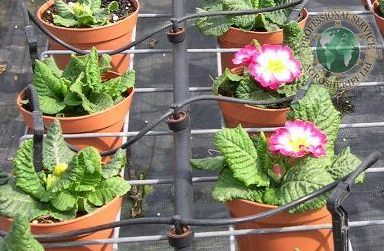
Is this possible? It turns out that yes. We received a request from one of the visitors to our site many years ago, and this request seemed to us to be of interest to many. Therefore, I decided to write an article and post it on our website. Hello!
I am planning an automated drip irrigation system for potted flowers in a private house. Please help to define the architecture and components.
Initial data: house of 600 squares: basement + 1 + 2 floors + insulated attic (winter). It is necessary to water the flowers automatically according to the schedule: on the windowsills (several pots on each) and indoors (on the floor, on the shelves). I deal directly with automation, but I have never done watering.
Initial thoughts on the project:
1. Install an irrigation barrel on the attic floor in those rooms and connect it to the water supply in the same way as the toilet flush cistern is organized (ie the mechanical shut-off valve).
2. Make the wiring with two vertical risers through all floors, and spread horizontally from these two risers along with the floors to the rooms under the ceiling (in a layer of plaster and behind tension/plasterboard (where depending on the finish). the wiring should be in a hatch in the area of a cluster of flowers, in which there will be a distribution comb and then to each flower along a tube.
3. Watering the plants is done through the drippers at the end of each tube, the drippers above the ground on the holder.
4. Materials: droppers, capillaries and tees, main pipelines. Barrel. Solenoid valves, Fittings, Controllers - see "Automation".
5. Automation: In a barrel. Install a water leakage sensor on the floor in those rooms. Install an electric emergency shut-off valve on the supply pipeline in front of the tank and in front of the mechanical valve. Also, install a water meter with a pulse output on the supply pipe. At each outlet from the barrel (2 risers), install solenoid valves to turn on / off irrigation using the controller. To control the irrigation system, use a freely programmable controller with digital inputs/outputs and a counting input (counting counter pulses): here it tastes and colors: ARIES, Segnetics, Siemens LOGO, Wago, Beckhoff, Phoenix Contact, etc. I will probably focus on the Russian Segnetics with a Modbus transceiver for inclusion in a home automation network, a display and buttons for local control/monitoring since it suits me in terms of price/functionality/quality ratio (digital inputs, outputs), and to take meter measurements I will later select a controller with a Modbus interface ... Automation will allow watering plants on a schedule and prevent an emergency situation of water leakage: leakage sensors monitor the leakage in the room with the barrel, and the counter allows you to measure the amount of water used during irrigation with the reference (if it exceeds, it means a leak), in case of an emergency, the controller closes the emergency valve on the water supply to the barrel.
Questions:
1. Selection of materials and equipment - see the above questions and opinions on the account of my choice. 2. Do you approve of my wiring? 3. What hydraulic calculations are needed for the system to work? 4. Is it necessary to use valves that regulate pressure? If so, which ones and in what places? 5. Which tube to choose for horizontal wiring (on the ceiling and along the walls), if: you want the possibility of leakage in the wall to be excluded (either the absence of connections, i.e. the branches in the hatches on the walls in inconspicuous places, or connections that are 100% will not flow, or each consumer group has its own branch from the riser). The issue of price/quality ratio is important here. Probably either polypropylene pipes, in which the joints are welded and pressed, or thin reinforced PVC pipes to each group of consumers (then if you lower it from the ceiling onto the wall without a connection, then you will need to make smooth arcuate bends. And is there enough elasticity so that when laying in the plaster did not deform it)? 6. Tell me, are there such small combs to branch through the capillary tubes directly to the flowers? 7. Criticism/advice / your opinion in general? As you can see, the letter is very detailed and requires the same answer. Such systems are widely used for landscaping residential and office premises in the West, for irrigating greenhouses and winter gardens. What should be the basis of the system? 
Definitely a dropper. High quality external compensated dripper that gives an accurate standardized water flow per unit of time. These droppers include droppers of the "Super-Tief" models and similar ones. They are produced with a water flow rate of 1, 2, 4, 8 liters of water per hour, and equipped with labyrinth tips, work very clearly and reliably.

The labyrinth handpiece stabilizes the pressure on all handpieces attached to the same dripper, thus equalizing the flow rate of the drippers even when the individual pots are at different heights. |